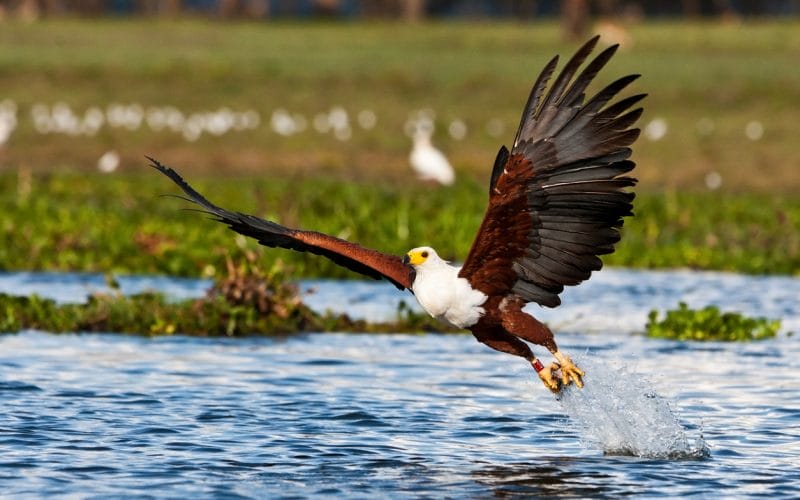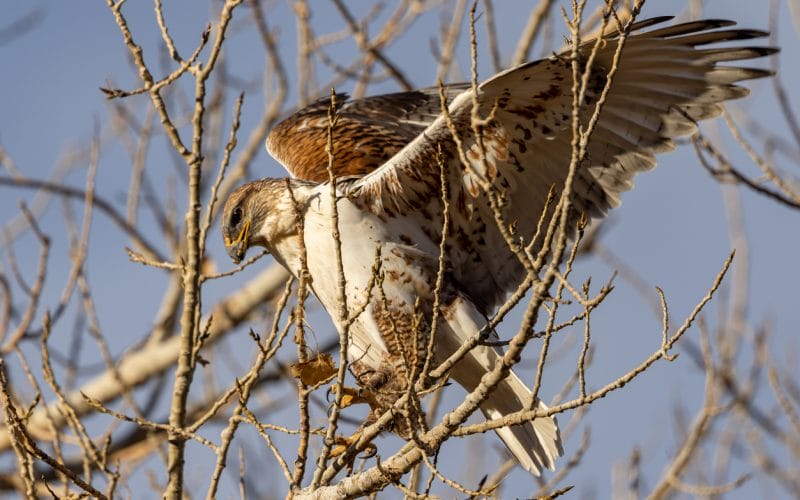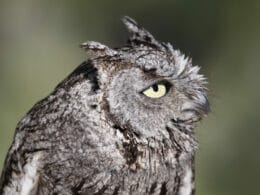The State of Minnesota is the 12th largest state in the US. With lots of habitats, it’s home to about 446 bird species that live in this state all year long or visit during the migration season.
If you’re particularly interested in Minnesota birds of prey, you’ve come to the right place. Minnesota is home to several species of hawks, owls, vultures, and other raptors that can be found around water bodies, in open country, or even urban areas.
Keep on reading to learn more about these wonderful birds.
11 Minnesota birds of prey
The name Minnesota comes from a Dakota-Indian word that means sky-tinted waters, as this state is famous for its rivers, lakes, and forests.
Across Minnesota, many birds of prey make this state their home, where they catch other animals or feed on carcasses. In this section, we’ll talk about the most famous raptors that can be found in Minnesota.
1. Red-tailed hawk
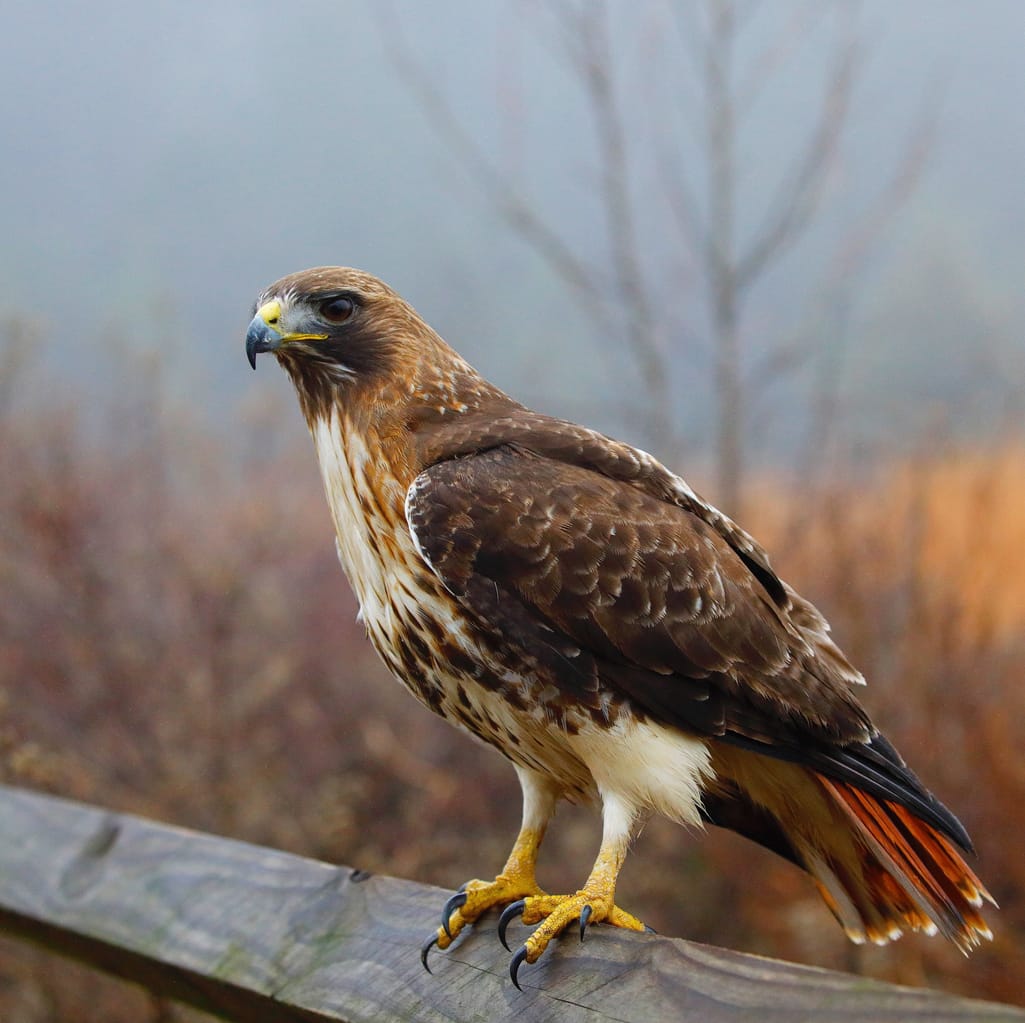
The Red-tailed Hawk is one of the most commonly found raptors in North America and is one of Minnesota’s largest birds of prey. It can be found around the open fields and near the woodlands near farms and cities.
It’s dark brown with a pale plumage on the underparts. The tail is yellowish with cinnamon reddish feathers that give the hawk its name.
Author Note: Female birds are usually 25% larger than males, weighing about 3.7 pounds.
The Red-tailed Hawk has a raspy scream that lasts about 3 seconds and catches its prey off guard. It usually feeds on mammals, rodents, reptiles, and birds. Your best chance to see this hawk is while you’re driving, and it’s unlikely to visit backyards.
Red-tailed Hawks prefer to build their nests on the crowns of tall trees where they can have a clear view of the land around them. They’re territorial and often chase other hawks, eagles, and owls.
2. Turkey vulture

Also known as the turkey buzzard, this vulture is one of the most widespread vultures in the New World. In Minnesota, it can be found nesting across the Mississippi and St. Croix rivers. It’s a large black-brown bird of prey with a featherless red head and a paler bill.
This vulture is easily noticed, thanks to the V-shape of its wings, which is seen while it’s flying.
It usually flies low and has a strong sense of smell that allows it to detect the gasses produced as part of the decaying process to locate fresh carcasses.
The Turkey Vulture lacks a syrinx but usually produces low hisses. It’s accustomed to living near urban areas where it feeds on dead mammals, birds, amphibians, and reptiles.
Luckily, it has a strong immune system that allows it to feed on dead animals without contracting botulism or salmonella.
3. Osprey

If you happen to be in Minnesota during summer, you might encounter an Osprey across the St. Croix River.
Ospreys are large birds of prey that mainly feed on fish, and they’re among the most widespread raptors in the world. The osprey is also called the fish hawk or river hawk.
Top Tip: Ospreys have glossy brown upperparts with streaked breasts and white underparts. Although most female birds of prey are typically larger than males, male ospreys are only slightly slimmer than females.
It hovers over the water and dives feet first to catch fish and then takes it back to its nest. The bird has barbed pads on the soles of the feet to help it catch slippery fish easily.
Ospreys are excellent anglers and usually catch one fish out of four dives. The largest recorded catch weighed as heavy as 2.5 pounds.
4. Bald Eagle

Outside of Alaska, Minnesota and Wisconsin host the biggest populations of Bald Eagles in North America.
The Bald Eagle has been the national emblem of the United States since 1782, and although it was once endangered, protection efforts lead to an increase in its numbers.
It’s a medium-sized bird of prey that mainly feeds on fish, and it’s not really bald. The Bald Eagle is brown with a white head and tail and has a large hooked yellow bill. Most female birds weigh around 12 pounds, while males weigh about 9 pounds.
The Bald Eagle can be found high in the sky, where it flaps its wings heavily. It typically nests in forests that are located near water bodies where the eagle can catch its food.
Instead of catching its own fish, the Bald Eagle usually harasses an Osprey until it drops its prey. Bald Eagles also steal fish from fishing mammals and anglers.
It’s less picky and can eat live or dead prey. In addition to fish, the bald eagle will feed on birds, amphibians, reptiles, and small mammals.
5. Peregrine Falcon

The Peregrine Falcon, which is commonly known as the peregrine, was historically called the duck hawk.
It’s famous for its high speed, which can reach up to 242 miles per hour during its high-speed dives as it drops to catch its prey, which makes it the fastest bird in the world and even the fastest member in the animal kingdom.
This falcon is the size of a crow with a dark head, blue-gray above, and barred underparts. It’s a cliff nester, with most of its nesting sites found along the north shore of Lake Superior and along the Mississippi River, although it can be seen in other locations across Minnesota.
While flying, the Peregrine Falcon can reach a speed of 34 miles per hour. It feeds mainly on birds that are as small as hummingbirds or as large as sandhill cranes. It’s one of the most widespread birds, and people have trained it for hunting for over a thousand years.
After the 1950s, the number of Peregrine Falcons declined due to the vast use of pesticides. However, worldwide recovery efforts were successful, and the bird was removed from the US Endangered Species List by the end of the 1990s.
6. Great Horned Owl
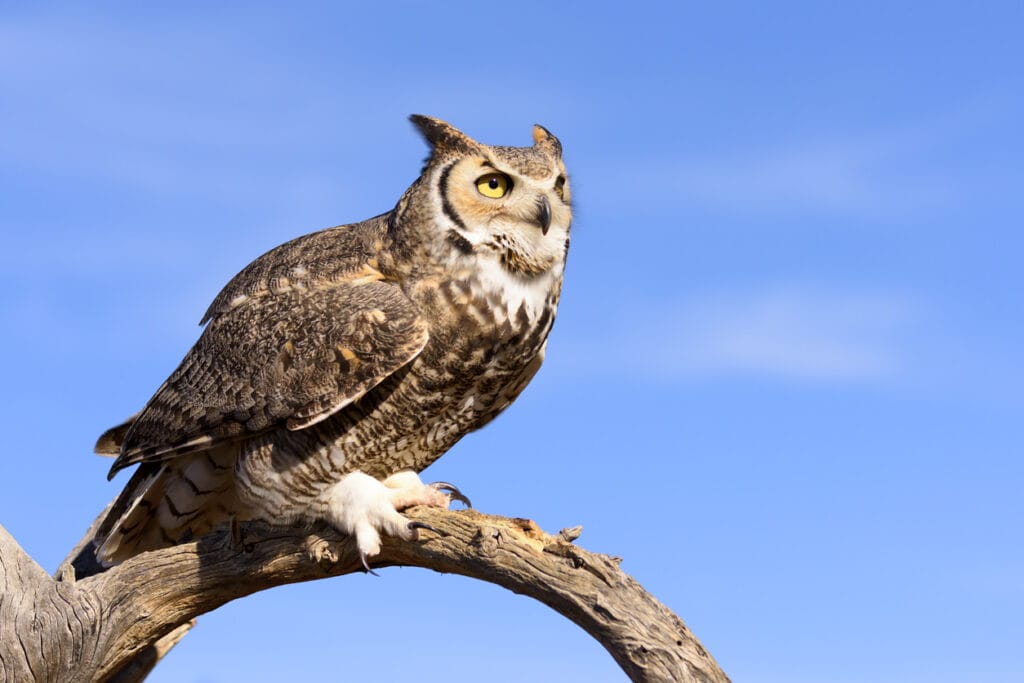
The Great Horned Owl is the most widespread owl in Minnesota. It can be found in several areas, including woodlots that surround agricultural areas, industrial development areas, city parks, and residential areas.
Also known as the tiger owl, the Great Horned Owl is rather large with a mottled gray-brown body and a reddish face. The word “horned” in its name refers to the prominent earlike tufts that give this raptor its scary look. These tufts provide the bird with better camouflage when it’s hiding in the trees.
This is a nocturnal bird of prey, and the best time to see it is at dusk when it’s ready to go hunting. It has a deep call that’s usually made of four or five hoots and can be seen perching on tree limbs and fence posts.
The Great Horned Owl probably has the most diverse diet compared to other raptors. It feeds on different animals that can be as tiny as scorpions or as big as other raptors like the peregrine falcon, ospreys, and other owls. It usually spots its prey from a perch but can also chase it among the bushes.
7. Merlin

The Merlin or the pigeon hawk is a rather small bird of prey that belongs to the family of falcons. Male Merlin are gray, while the females are brownish. Both genders are streaky and have white bands on the tail.
This raptor can be found in Minnesota’s northeastern and north-central parts, nesting and hunting along lakeshores. Over the years, Merlin have adapted to city life, and some of them don’t even migrate.
During medieval times, the Merlin was known as the lady hawk, and the birds were used for hunting skylarks. Merlin usually hunt in pairs, where one Merlin would attack flocks of waxwings from below, while another would come and catch a confused bird.
The merlin usually feeds on songbirds and shorebirds. However, it’s also known to feed on large insects like grasshoppers, in addition to bats and nestlings. It doesn’t build its own nest but usually takes over the nests built by crows and magpies.
8. Red-shouldered Hawk

The Red-shouldered Hawk hasn’t been recorded in Minnesota until 1935, but today it can be found as a summer resident. Male birds usually weigh 1.2 pounds, while female birds are heavier, weighing about 1.5 pounds.
Top Tip: This hawk has a checkered black and white body with a red breast and shoulders. The tail is black and marked by white bars.
The easiest way to locate the Red-shouldered Hawk is to learn its distinctive rising whistle. It hunts from a perch or while flying and mainly feeds on small mammals, rodents, and reptiles.
The American Crow usually mobs this hawk, but sometimes both birds would join forces to chase an owl away. The Great Horned Owl usually steals nestlings, but this hawk steals young owls from their nests too.
9. Northern Harrier
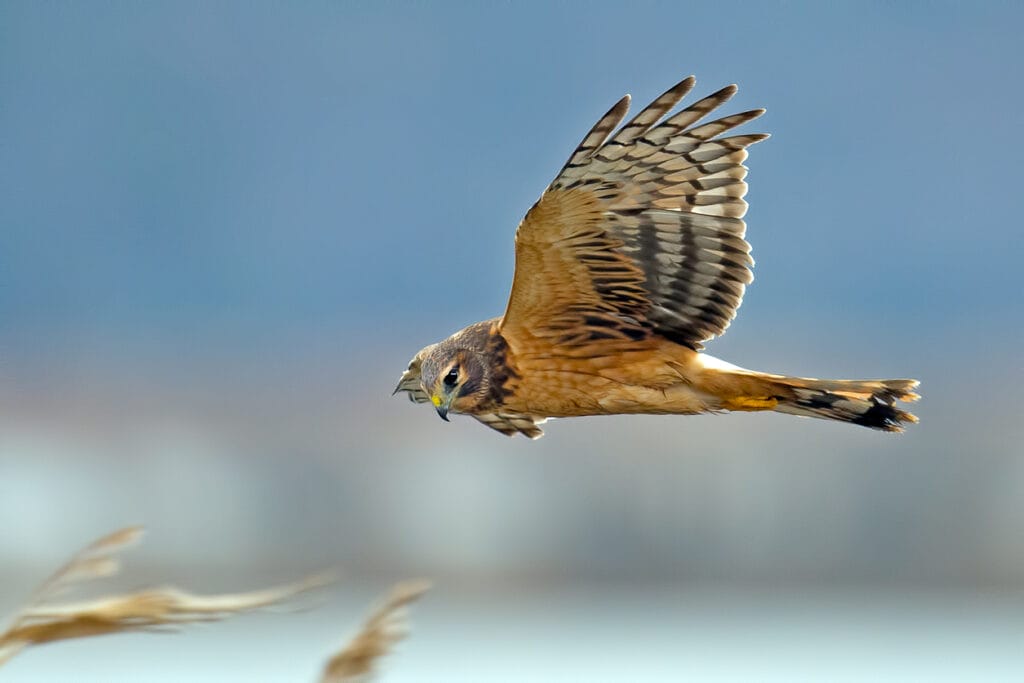
The Northern Harrier is found in several locations across Minnesota, usually near the northern Great Plains. It has an owl-like head, and the body is gray with whitish below. Female and young birds are brown instead of gray.
This raptor flies low while hunting, and has strong senses of vision and hearing to locate and catch its prey. The shape of the face helps as the stiff facial feathers help to direct the sound to the ears.
It feeds on small mammals and rodents, but if it catches bigger prey like a duck or rabbit, it will try to drown it first. Male Northern Harriers are more likely to feed on birds than female harriers that usually feed on small mammals.
The female Northern Harrier chooses the nesting site and builds its nest on the ground. The male bird might start building the nest platform, but the female usually arranges the nesting material.
Several animals like skunks, raccoons, badgers, foxes, dogs, and crows will attack the Northern Harrier’s nest and steal eggs or nestlings.
10. Swallow-tailed Kite
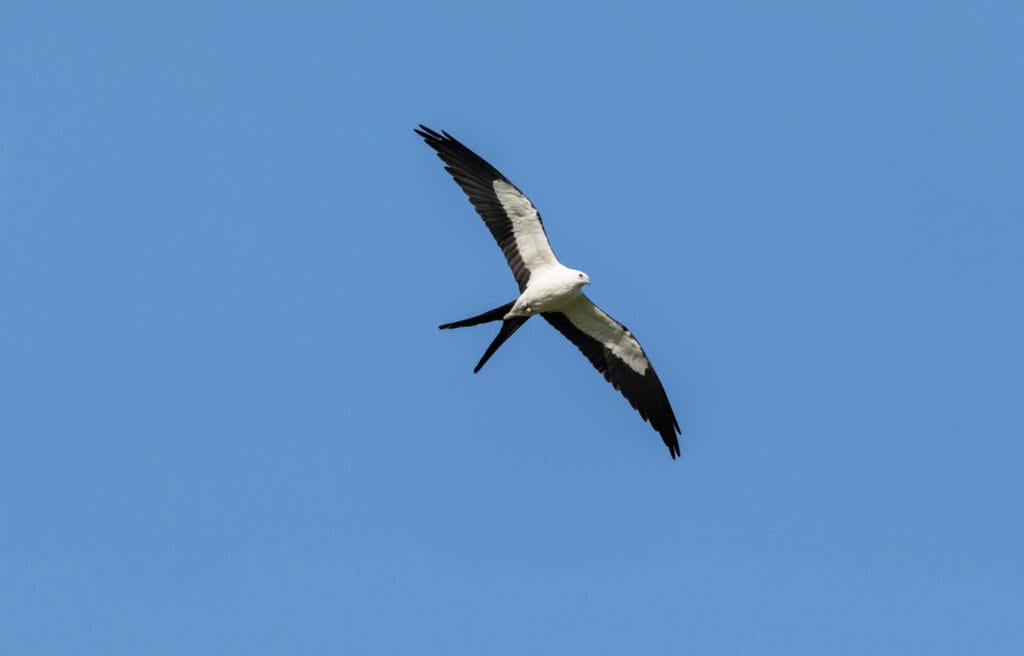
The Swallow-tailed Kite is the largest among North American kites and can be found across the swamps and lowland forests of Minnesota. It has a bright white head and glossy black plumage with some white linings on the wings.
It has a slim body, and although it’s about the same height as the red-tailed hawk, it’s almost half its size.
The Swallow-tailed Kite flies low and circles around trees to find its prey. It can be noticed thanks to its acrobatic flying style, although most of the time, it soars too high to be detected.
Author Note: The Swallow-tailed Kite migrates to South America at the end of the summer.
This kite hunts on the wing, usually feeding on flying insects, and it consumes its food while flying. However, it also feeds on snakes, lizards, frogs, bats, nestlings, and sometimes fruits.
Adult Swallow-tailed Kites prefer to feed their young smaller vertebrates, which the male catches. Then, the male kite passes the prey to the female, where she tears it and feeds it to the young birds.
11. Ferruginous Hawk
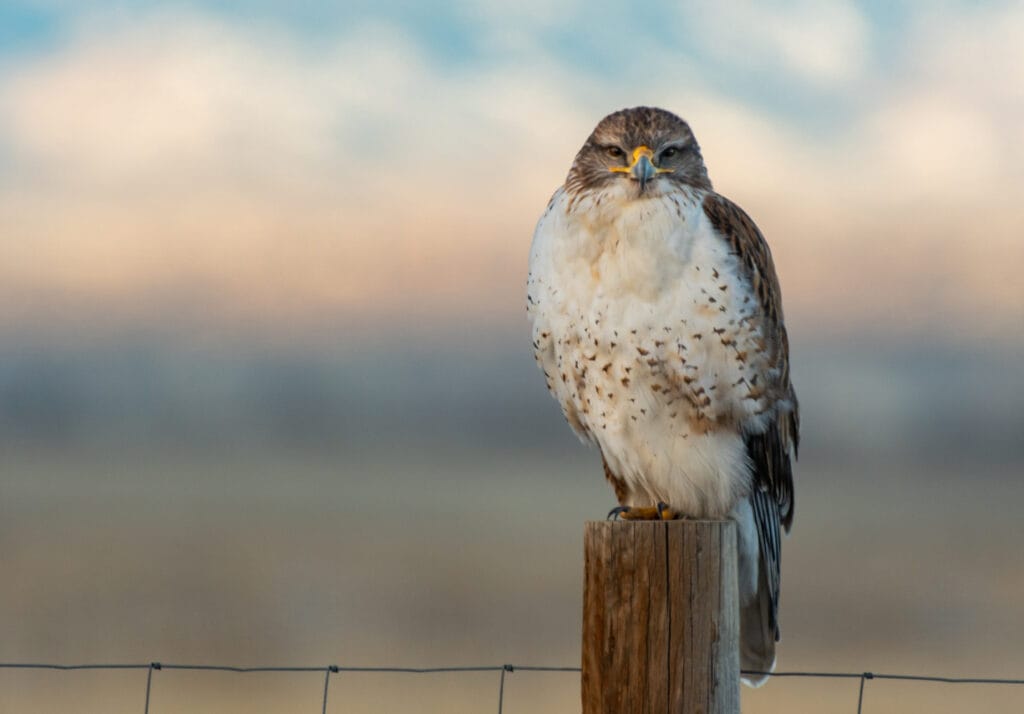
The Ferruginous Hawk is a large bird of prey that can be found on the western edge of Minnesota and is usually seen circling open country areas. It has long wings, a large pale head, rusty upperparts, and whitish underparts.
This hawk soars in the key and hovers while it hunts, but it also sometimes hunts on land. It can be seen while it’s perching on poles, but it’s hard to detect on land, although it occasionally hops and runs to catch its prey.
Author Note: It mainly feeds on small mammals like ground squirrels, rabbits, and prairie dogs.
During winter, it might gather in prairie dog towns to catch the prey when it emerges from the underground burrows. These groups also attract the attention of other raptors like bald eagles.
The Ferruginous Hawk also feeds on reptiles, birds, and rodents. It’s an adaptable nester and can choose a nesting site that can be as high as 65 feet or as low as ground level. It often also refurbishes an old nest or takes an existing nest of a hawk or crow.
Wrap Up
The birds of prey in Minnesota can be found in different locations, which is great news for every birder who’s interested in learning more about these skilled hunters.
We hope you enjoyed our guide on common Minnesota birds of prey. Keep an eye on the sky to see some of these amazing birds, and you’ll be amazed by how majestic they are!
FAQ
The Red-tailed Hawk is the most common bird of prey in the U.S. and also in Minnesota. Its success may well be to do with its habit of looking for prey and roadkill along rural and semi-rural roads.
The Ferruginous Hawk is the biggest in Minnesota. It has a wingspan of 53 – 56 inches. Compare that to the Sharp-shinned Hawk with its wingspan of 17 – 23 inches.
The very rare and endangered Gyrfalcon is the largest in Minnesota. It only visits occasionally in winter so it is pretty difficult to spot.





